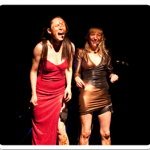Therese Raquin – a musical adaptation by Nona Shepphard for the Finborough
Therese Raquin – a musical adaptation by Nona Shepphard for the Finborough
(The edited version for Exeunt magazine is at: http://exeuntmagazine.com/reviews/therese-raquin/)
Nona Shepphard’s musical of Therese Raquin is boldly tagged ‘a radical adaptation.’ Considering Emile Zola’s novel incited condemnation for its immorality, ‘radical’ seems an appropriate modern treatment.
Watching this musical unfold, it is easy to discern the tensions between naturalism and melodrama present in Zola’s original work. In the course of the show, we are presented with a milieu of lower-middle-class tradespeople and clerks undertaking the mundane routines of walking to work through Paris streets, selling buttons, playing dominoes. We are also presented with an adulterous affair between central characters, Therese and Laurent, their murder of Therese’s feeble husband, attempted murder of each other and final suicide pact. Zola’s aim to examine Therese and Laurent as products of their physiological conditioning is nicely reflected in the choral refrain ‘blood and nerves…blood and nerves.’ Indeed the chorus’ introduction of the two lovers ‘In the world there are billions of human animals, here is one…Therese/Laurent’ is a strong proposition of engagement with Zola’s view.
As the house lights dim, an ensemble of figures dressed in modern edits of nineteenth century garb fill the set. The seven seamlessly weave around a wooden framework surrounding a small, interior space. Suggestive of the infrastructure of dank, old houses, this puzzle of open and shut doorways and window frames is sparsely littered with props – a display of gaiters from Madame Raquin’s shop, a candle-holder, a blanket…The cast gathers, centre stage, choir-like, singing the status-quo of Madame Raquin’s household. We learn that the matriarch has overseen a marriage between her coddled son, Camille, and strange, quiet niece, Therese. What is notable among this chorus and between the three ‘river-women’ who represent Therese’s psyche, is an absence of individualism. All walk and sing with a distinct manner and timbre of voice, but the audience member is left thirsty for more non-verbal information about the composite parts of this knowing, nineteenth century crowd. The Finborough’s intimacy as a venue demands detail and the stasis of the chorus during the drama’s opening highlights this.
As the drama’s crises escalate, the relationship between movement and melodrama becomes neatly bound together. Motifs with a contemporary dance aesthetic are used to express Therese and Laurent’s antagonistic tormenting of each other. The two cling, flail, embrace and fall. Zola’sintention to present the lovers guilt through a set of physical symptoms (insomnia and nervous attacks) is thereby neatly conveyed. Atherton andLewis execute these episodes with conviction and the right degree of front-footed amplification. But although both leads are consistently credible as virile peasant Laurent and intense, introverted Therese, these motifs fall just short of tangible chemistry. Attraction between the couple is signified but not palpably dangerous, despite strong characterisation.
There are many impactive moments in the piece. Therese’s reflection on how Camille’s murder has killed her rapture in the song ‘If I had known’ is one such moment. Repeated rituals during Madame Raquin’s games night (including the addictive song ‘Thursday Nights’ ) constitute others. The famous moment in which the, now paralysed, Madame Raquin begins to spell out the perpetrators of Camille’s murder with her finger was, however, an approximate rendering and largely brought to life by the actor’s commentary.
A musical by nature of the medium demands broad strokes to deal with heightened emotive and narrative content. Therese Raquin, with itsmelodramatic plot-points and host of tragic little details (the bite-mark left by Camille on Laurent’s neck) makes a perfect candidate for a radical shift of format. Because of this rich combination of small and operatic actions, the leap from naturalism to populist opera is successful. (Laurent’s ‘blood’ and Therese’s ‘nerves’ are equally represented.) Indeed, the book’s structure of sections from domestic malcontent to repressed horror, violence and final self-destruction could be termed symphonic. Nona Shepphard and Craig Adams have created an adaptation which skilfullyretains fidelity to Zola’s story while robustly exploiting the immersive potential of theatre. Despite this show’s radical journey from nineteenth century printing press to musical, its treatment in the eyes of a post postmodern audience will communicate as highly intelligent, engaging but ultimately tame.



